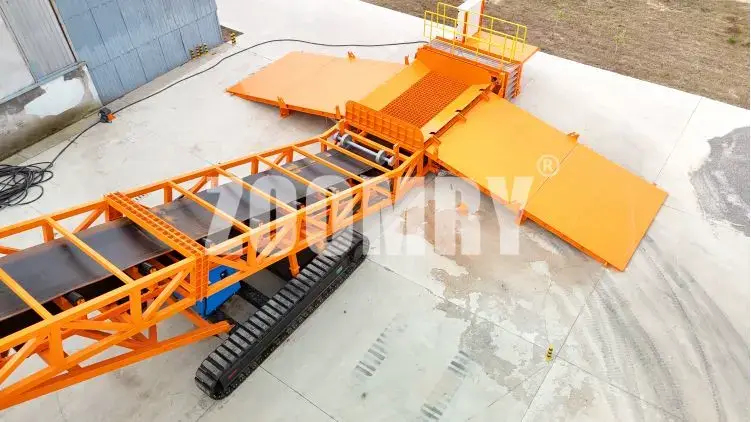Time:2025-05-04 13:02:56 Number of Clicks:
In the bulk material handling industry, crawler truck unloaders have become core equipment in heavy industrial applications like mines, ports, and steel plants due to their superior terrain adaptability and high-load efficiency. However, the track system—the "mobile lifeline" of these machines—harbors a persistent technical challenge: track wear and derailment risks. According to the International Bulk Material Handling Association's (IBMH) 2023 report, track system failures account for 42% of unplanned downtime causes, with direct losses from track link fractures and derailments ranging from $12,000 to $80,000 per hour, potentially triggering production interruptions, safety hazards, and environmental incidents.
ZOOMRY, leveraging 20+ years of global project experience and data from 3,000+ equipment units, provides an in-depth analysis of track system failure mechanisms, helping customers extend track life by 80% and reduce derailment risks by 95%, truly achieving "steady and long-lasting" performance in bulk material handling equipment.

The crawler truck unloader's core advantage lies in its modular track chassis design: hydraulic drive wheels move track links to contact the ground, enabling 360° free steering and rough terrain mobility. However, this dynamic contact mechanism also introduces two typical failure modes:
ZOOMRY's global service data shows 80% of derailments exhibit progressive deterioration:
ZOOMRY adopts a "Design for Failure" (DFF) philosophy, implementing three technological innovations to enhance intrinsic safety:
If you have any questions about preventing track wear and derailment risks in crawler truck unloaders, please contact us using the information below.
| Inspection Item | Interval (hours) | Standard Parameter |
|---|---|---|
| Link thickness measurement | 500 | Wear <10% original thickness |
| Tension calibration | 250 | Set value ±50kN |
| Bolt preload check | 100 | Torque deviation <±5% |
ZOOMRY's proprietary remote monitoring platform uses vibration spectrum analysis and temperature trend prediction to provide 200-300 hour early warnings for potential failures.
In 2024, ZOOMRY faced a technical challenge at the Obi Island nickel mine in Indonesia. Located near the equator with ambient temperatures reaching 38°C and humidity exceeding 85%, the lateritic nickel ore's abrasiveness index (AI) of 0.82 (where AI>0.6 is considered highly abrasive) posed severe durability challenges. The project's ZRLD-TU1800 crawler truck unloader needed to maintain continuous throughput of 1,800 tons per hour with 92%+ operational stability—demanding near-perfect track system reliability.
ZOOMRY's engineering team implemented a three-tier strategy. First, material and structural breakthroughs: To address abnormal wear on link contact surfaces, they innovatively laser-engraved diamond-shaped anti-slip patterns, increasing the friction coefficient from 0.35 to 0.45. Guide wheel covers were upgraded to carbon fiber-reinforced polyurethane, tripling wear resistance versus traditional rubber. For grease failure in high heat/humidity, the team developed a "dry lubrication system"—blending 5% nano-graphene into NLGI #2 grease with compressed air pulse cleaning, reducing link friction by 18% while removing 90%+ abrasive particles per cycle.
The pivotal advancement came in intelligent control. Integrating BeiDou satellite positioning with high-precision IMUs enabled real-time monitoring of equipment tilt. When lateral inclination exceeded 2°, the dynamic load management system instantly adjusted weight distribution. Meanwhile, a deep learning-based ore size-speed matching model optimized travel paths according to pile morphology, controlling dynamic load fluctuations during turns within ±12%.
After 12 months of operation, this technological package delivered exceptional results. Track system lifespan extended from the industry average of 6,000 hours to 9,500 in highly abrasive laterite—reducing unplanned replacements from 3 to 1 annually. Unplanned downtime fell below 1.2 hours monthly, improving operational stability by 67% versus peers. Most remarkably, energy consumption dropped to 0.38kWh per ton—27% below industry benchmarks—saving over $150,000 annually in energy costs alone. This success establishes new reliability standards for crawler truck unloaders in tropical, high-abrasion environments.
As a leader in China's bulk material handling equipment sector, ZOOMRY continues to drive technological innovation, delivering safer, smarter, and more economical crawler truck unloader solutions. We invite global partners to jointly explore the intelligent future of industrial equipment, maximizing value from every ton of material flow.
Copyright © 2002-2024 Zoomry Group Company Limited